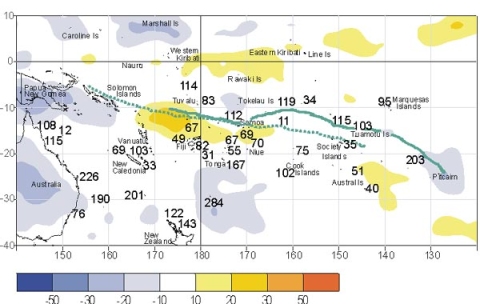Climate developments in November 2001
Monsoon well established in the northwest Areas of below average rainfall from the Coral Sea across to French Polynesia
The monsoon was well established over Indonesia, northern Australia and Papua New Guinea during November, with outgoing long-wave radiation (OLR) anomalies below average, indicating active convection, over these areas as well as parts of the Solomon Islands. Convection was also enhanced over the seas between New Zealand and Tonga, and over Pitcairn Island. Some areas within these regions received at least 200% of average rainfall, including islands in the north Tasman Sea and Gambier Island in French Polynesia. Rainfall totals were also enhanced over northern New Zealand, with totals at least 120% of average. Below average rainfall continued during November in the Coral Sea, with totals about 10% of average on Willis Island. Low rainfall, less than 50% of average, also persisted for the third month running throughout central Tonga. Rainfall was 75% or less of average throughout much of New Caledonia, Vanuatu, Fiji, Samoa, Tuvalu and Kiribati.
The SPCZ was near its average position from Tuvalu to Samoa, but it was displaced further north than normal in the east.
Very high November rainfall was recorded at:
| Country | Location | Rainfall,mm | % of average |
|---|---|---|---|
| French Polynesia | Gambier, Rikitea | 288 | 203 |
| New Zealand | Raoul Island | 253 | 284 |
Unusually low October rainfall was recorded at:
| Country | Location | Rainfall,mm | % of average |
|---|---|---|---|
| Cook Islands | Pukapuka | 29 | 11 |

